

As TikTok continued its meteoric rise, the challenge was to refine its visual identity while maintaining the platform’s dynamic, creator-driven essence. The goal was to develop a cohesive yet flexible design system that unified its global brand while allowing for local nuance. This refresh encompassed a comprehensive strategy, including motion theory, an extended color palette, custom typography, photography, video guidelines, and an adaptable grid system that reflected the fluidity of content creation. The result was a scalable design philosophy that empowered internal teams, agencies, and creators to maintain consistency without stifling creativity. Collaborating with Wolff Olins, the team and I delivered a brand system that reinforced TikTok’s role as a cultural powerhouse. The new identity captures the platform’s perpetual movement, rooted in the upward swipe interaction, while keeping content at the forefront. This work helped TikTok ‘age up,’ expanding beyond Gen Z to a broader, multigenerational audience. With 1 billion+ active users and growing, TikTok’s refreshed brand system continues to fuel engagement across industries, from education and music to business and entertainment.

"TikTok saved my life." - Dame Judy Dench
We set out to create a more cohesive design system that could flex to local nuance while preserving a strong global identity. The result was a unifying philosophy that informed every toolkit and guided our design decisions. Deliverables spanned motion theory, an expanded color palette, grid systems, custom typography, brand photography, video guidelines, and more. On the TikTok for Business side, I helped expand the toolkit and branding, building on the strong foundation established by Wolff Olins. My focus was on evolving the design system to support a broader range of campaigns and partners, ensuring it could flex while staying true to TikTok’s unique creative spirit. This work extended the brand’s reach beyond the core platform, giving marketers and creators more ways to connect with audiences. The result was an expanded, adaptable system that amplified TikTok’s cultural impact and made it easier for business initiatives to tap into the energy, diversity, and movement that define the app. Between our internal teams across regions and functions as well as our agency partners at Wolff Olins we delivered a cohesive system for a young brand that not only packs a punch but covered all it's needs as we scaled into a large ecosystem with so many worldwide touchpoints.
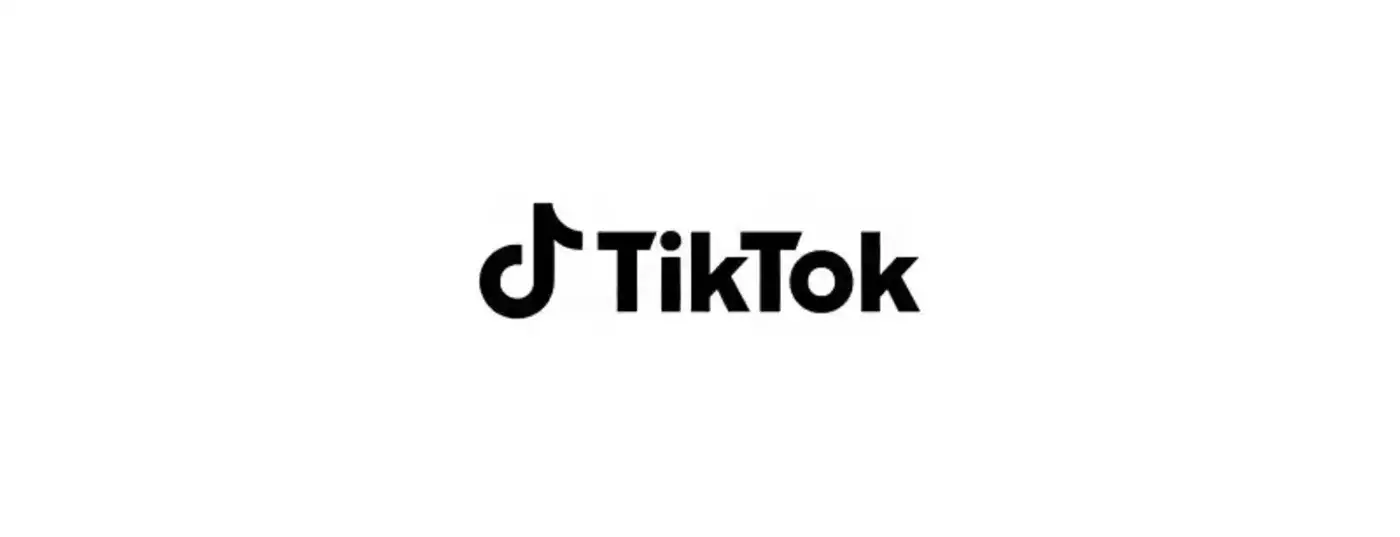
.webp)
I took part in the creation of a unified and cohesive visual identity for TikTok and TikTok for Business in an over year long collaboration with our agency Wolff Olins. We began with an in-depth competitive analysis, examining how other brands approached the relationship between their business and consumer-facing identities. This research helped us pinpoint opportunities for differentiation and areas where we could strengthen our own presence while our user side team spearheaded a more consumer and campaign focused brief. From there, we carried out a comprehensive brand audit that reviewed every touchpoint, including regional marketing materials, social content, in-app visuals, presentations, and websites. This revealed missing components and inconsistencies across regions that were diluting the brand’s impact.
The design system emerged from an urgent need to bring cohesion and scalability as the brand matured and regional markets deepened their penetration within distinct funnels. TikTok had grown from a disruptive newcomer into a global platform with diverse audiences, verticals, and advertiser relationships, which created increasing pressure on consistency and clarity. Without a unifying system, creative output risked fragmentation, diluting both recognition and trust at a critical stage of growth. The framework provided a shared visual and strategic foundation that could flex for local nuance while reinforcing a global brand voice. It enabled regions to activate within their own cultural contexts without drifting from the core identity, aligning internal teams, partners, and agencies around one scalable approach. This balance of structure and adaptability was essential to elevating TikTok from a fast-growing app to an established cultural and business powerhouse.
.jpg)
Thinking TikTok first when developing a brand system is essential because the platform itself has redefined how culture is created, consumed, and shared. A TikTok-first approach ensures the identity is not built in abstraction but directly rooted in the behaviors, tools, and creative language of the platform. This means designing for vertical video, motion as a core principle, and community-driven storytelling as the foundation rather than an afterthought. By aligning the system with the lived experience of discovery, participation, and remix culture, brands can build identities that feel native and credible in the environment where their audiences spend the most time. This approach also creates scalability, as assets built for TikTok can extend outward into other channels with consistency and cultural resonance. Rooting a brand system in the platform experience ensures it is not only visually coherent but also strategically relevant, future-proof, and built to thrive where culture is moving fastest.

Our goal was to sharpen the brand and build a cohesive design system that could maintain a strong global identity while respecting local nuance. We created a flexible system grounded in a clear philosophy that guided every toolkit and informed our design decisions. The scope of work included motion theory, an extended color palette, grid systems, custom typography, brand photography, video guidance, and other foundational elements that would bring consistency without sacrificing creativity. We made the process highly collaborative by inviting regional Creative Labs to participate in biweekly co-work sessions. These sessions created a space to share progress, gather immediate feedback, and make adjustments in real time. By engaging teams from around the world in shaping the system, we ensured the guidelines were embraced and adapted with confidence. Working closely across brand, creative, business, marketing and many other functions allowed for us to gather a full understanding of all of our brand touchpoints.
.jpg)
The final system reflected TikTok’s values of authenticity, creativity, and expression. We introduced expressive staggered headlines to keep layouts fresh, dynamic grid compositions designed for energy and variation, and a photography style that celebrated the diversity of the TikTok community worldwide. We developed bold, energetic data visualizations for both static and motion formats, created a vibrant sticker library to add emphasis and personality, and reimagined the TikTok logo into branded patterns that could maintain visual presence even without imagery.

I spearheaded the TikTok For Business creative ecosystem, leading the development of scalable design systems that unified our global B2B identity while empowering regional teams to move faster and stay on brand. While the user-facing side focused on campaign-specific storytelling and vertical activations, my work centered on building the foundational assets that powered them, including typography systems, motion and presentation toolkits, event franchise templates, and swag and brand-extension guidelines. Both sides were working in parallel, complementing each other’s goals, and the next stage was merging everything into one cohesive toolkit, which I helped ensure was executed with precision and high creative standards that were befitting of a company that had finally reached our level of global status and market penetration.
.jpg)
From the outset, our goal was to establish a best-in-class brandbook that defined how TikTok should be represented visually across every touchpoint. We recognized that as the brand continued to scale globally, it required a single source of truth that would unify our identity while also enabling creativity. The intent was to create a framework that balanced rigor with flexibility, ensuring that every application of the brand looked and felt unmistakably TikTok, while still adapting to the wide variety of cultural contexts in which it lives. Especially existing in a hyper growth startup stage, we knew that we were building the plan while we were flying it.
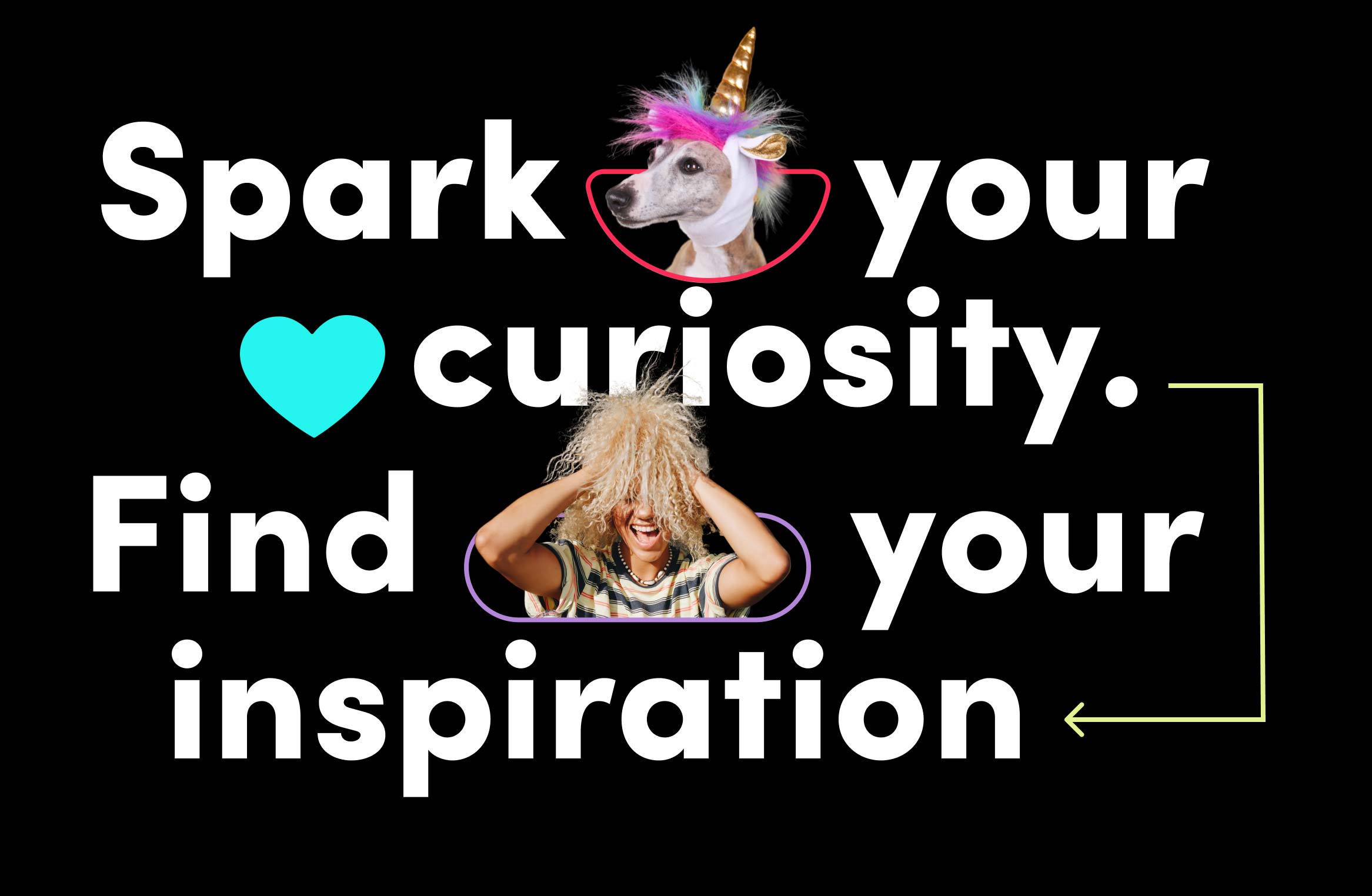
TikTok’s design language reflects the same sense of discovery and joy that defines the For You Page. The palette is bold and unapologetic, with colors like Splash and Razzmatazz that create an instant sense of energy and contrast. Photography is vibrant and expressive, capturing people in real, unscripted moments that radiate confidence and individuality. The use of Sofia Pro gives the system a modern and human voice, balancing precision with warmth and rhythm. Each visual choice works together to evoke curiosity and delight, turning design into an open invitation to explore, create, and connect. The result is a visual identity that feels alive and full of motion, mirroring the spark that makes TikTok such a boundless source of inspiration.
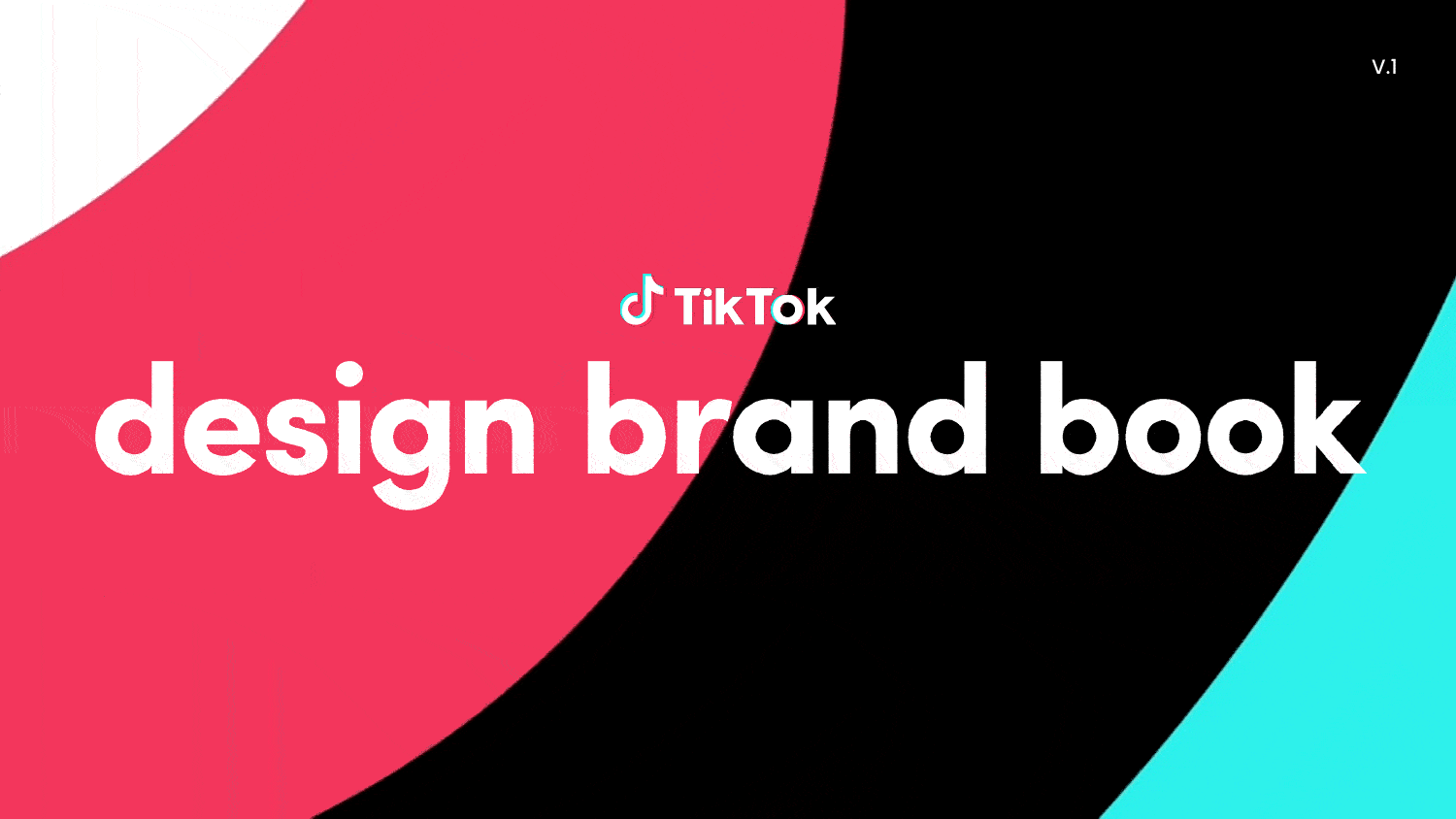
The team worked to develop a guide that is both comprehensive and inspirational. It provides clear rules on core elements such as logo usage, color, typography, and art direction, but also introduces principles that encourage discovery, adaptability, and creative remixing. My role was to define the overarching design direction and to make certain that the system reflected the brand strategy of being real, lively, daring, and encouraging. Beyond setting guidelines, I ensured the brandbook empowered global teams with the confidence to create, giving them a flexible but consistent foundation that can scale with new products, partnerships, and campaigns. In essence, the brandbook is not a static rulebook, but a living reference designed to evolve alongside TikTok’s culture and community.
.jpg)
Creating a global deck template was a foundational undertaking for ensuring consistency and excellence across all of TikTok’s business collateral. The template had to function as more than a presentation tool. It became a core asset that unified how teams across regions communicated TikTok’s story, products, and value proposition. Given the scale of the organization, it was critical that the system balanced polish and flexibility, enabling everything from executive presentations to client-facing sales materials to feel cohesive and on-brand. This required a deep focus on typographic standards, alignment rules, and color use, as well as the ability to adapt to different content needs without losing the integrity of the visual system. This was a key feature that my team undertook of the full toolkit, and we were able to build out a very robust set of solutions across the org.
.jpg)
The process was a large-scale effort that evolved over multiple versions and updates. I led my team, including Dana Spomer, Joy Seet, and Vanessa Rizk, in expanding the range of slide options and refining each category. The template ultimately encompassed a wide spectrum of formats, including cover and agenda slides, speaker and quote pages, TikTok showcase layouts, data visualization options, case study formats, and even specialized slides such as timelines, challenges and solutions, and budget frameworks. Each category was designed with intention, ensuring teams could easily tell stories that were strategic, data-driven, and visually compelling. What emerged was a robust set of templates that not only supported the daily work of hundreds of colleagues worldwide but also elevated the standard of how TikTok shows up in every conversation with partners, clients, and stakeholders. These elements laddered into the larger conversations and deliverables that we were slowly building up towards.

The TikTok design system was built to serve as a living framework that captures both the structure and spontaneity of the platform. At its core is a modular grid and bold palette that anchor the identity while allowing for flexible interpretation across channels, regions, and audiences. The system encodes discovery into its DNA, using typography, motion, and compositional logic to create moments of surprise that still feel consistent and on brand. It brings together rhythm and clarity, building a foundation that can flex across storytelling, product, and campaign environments while keeping the same heartbeat of authenticity and play. The visual language invites experimentation within a shared creative code that keeps the brand recognizable in any context. It is designed for collaboration and adaptation, balancing precision with expressive freedom that reflects TikTok’s culture of participation. The idea is to center surprise, joy and discovery while making TikTok feel accessible and human.
.jpg)
Discovery sits at the foundation of the design philosophy. It shapes how visual hierarchy guides attention, how motion creates continuity, and how transitions encourage exploration rather than distraction. Every choice, from typography scaling to sound alignment, supports a sense of curiosity and intention. The grid behaves like a navigational framework, giving creators and designers a structure through which new ideas can emerge organically. Discovery acts as the guiding principle that keeps the system evolving, encouraging visual storytelling that feels fresh, cohesive, and inherently connected to TikTok’s creative energy.
.jpg)
TikTok’s color system is built on clarity, contrast, and rhythm. Each tone has a specific function in maintaining legibility and emotion across digital space. Splash brings a sense of vibrancy and energy that feels distinctly native to the platform, while Razzmatazz adds warmth and human connection through its pink-red tone. Lemon and Pacific act as balancing notes, providing contrast and pace against the darker foundation colors. Every hue is calibrated for accessibility and visibility on screen, maintaining harmony between playfulness and precision without relying on gradients or effects. The result is a visual language that feels alive but remains consistent and intentional in every use.

We paid attention that every element was designed to scale, ensuring that whether applied to digital surfaces, physical merchandise, or global campaigns, the identity retains coherence without losing energy. By grounding the system in principles rather than rigid templates, we created a toolkit that empowers teams and creators to express themselves while reinforcing a unified brand voice. This approach reflects TikTok’s role as a cultural engine where content, community, and creativity intersect. The result is a system that feels both timeless and adaptive, capable of evolving alongside the platform itself.
TikTok’s design system was built to reflect the platform’s universality, where a single space means something entirely different to each user. We leaned on Sofia Pro as our primary typeface because of its clarity, warmth, and versatility, a font that feels equally at home in a creator’s bedroom setup, a boardroom presentation, or a global event stage. Its geometric simplicity provided a neutral canvas, allowing vibrant content to take center stage. In app we were using Proxima Nova as well as a few custom ones for our video editing interface.
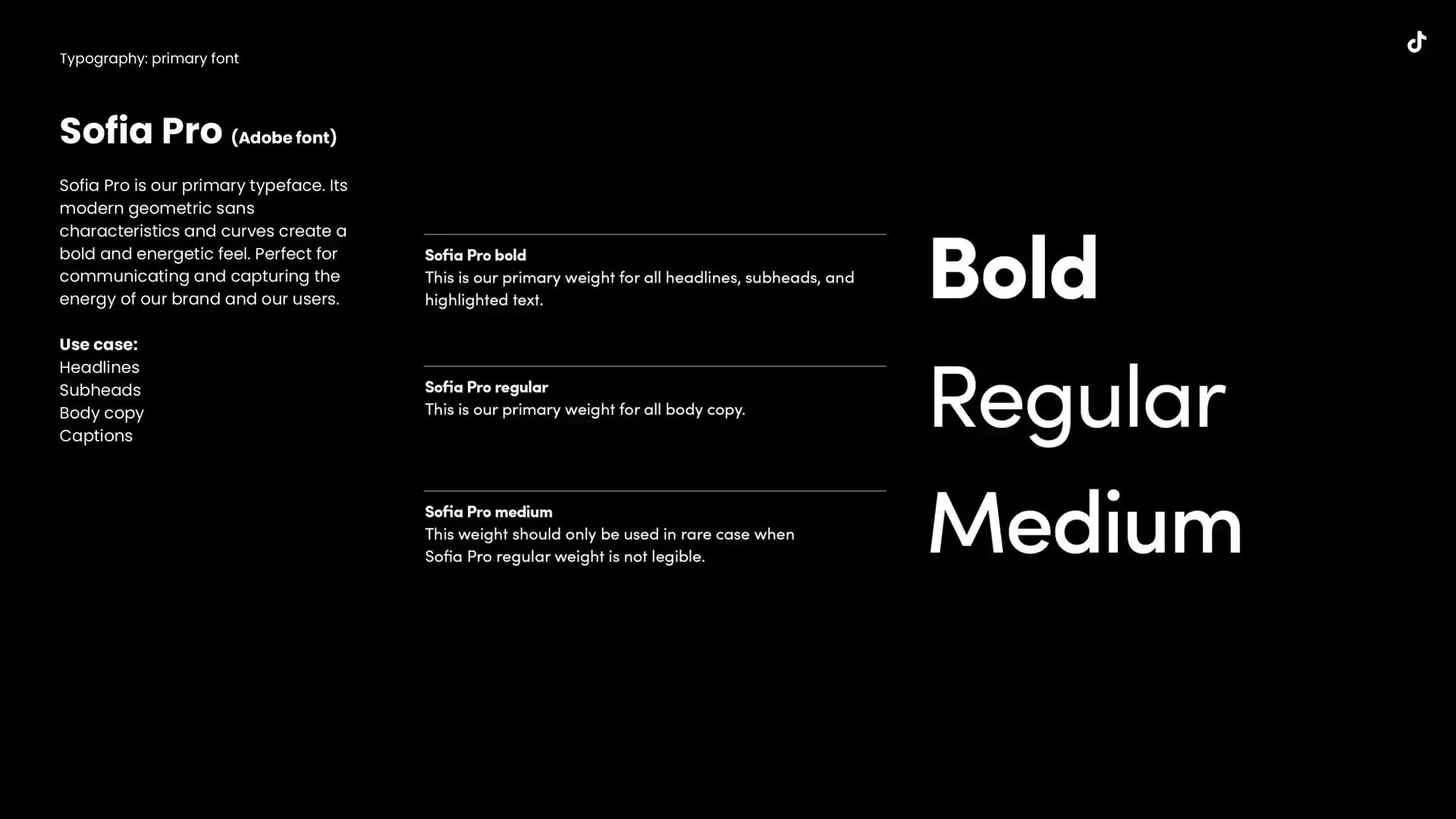
Sofia Pro was created by Olivier Gourvat and released through Mostardesign in 2009 as a contemporary geometric sans serif inspired by early twentieth-century European modernism. Its structure is based on rational geometry, yet it retains subtle human proportions that give it a smooth and approachable rhythm. The typeface was designed to work across a wide range of weights and optical sizes, making it both expressive and reliable. Its letterforms are clean and architectural, built on circles and vertical precision rather than soft or rounded curves. This foundation allows it to convey authority and clarity without losing warmth. Within TikTok’s brand world, Sofia Pro acts as a bridge between technology and humanity, offering a clear and consistent typographic system that can hold emotion, humor, and motion without distortion. It carries a sense of modern craftsmanship, echoing the platform’s dual commitment to structure and play, and serves as the visual voice through which the brand speaks to millions every day.
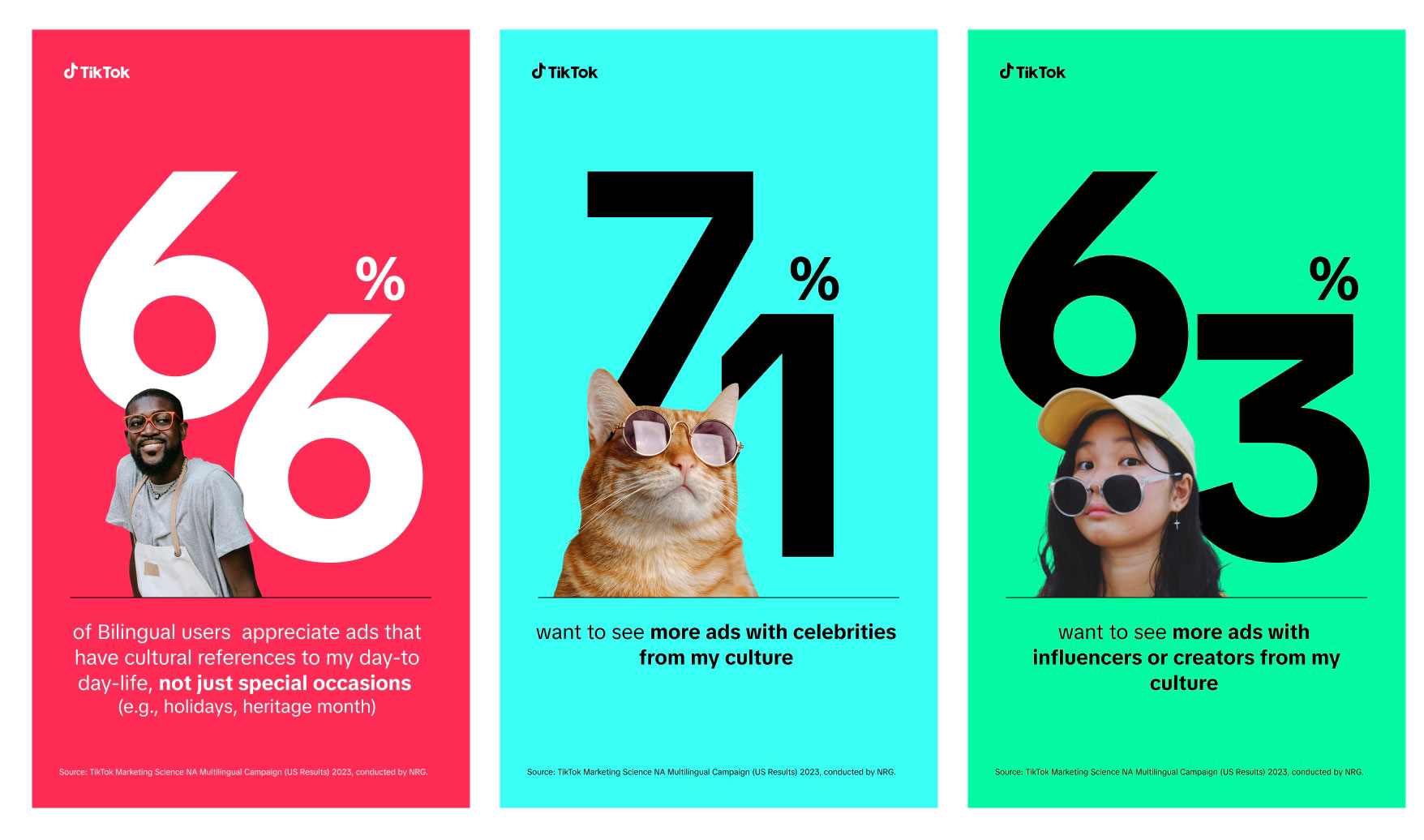
I worked closely with my direct report Henry Kaye to concept, design, and art direct a comprehensive Data Visualization toolkit that addressed the unique needs of our B2B organization. We recognized early on that standard templates would not be sufficient for the volume and complexity of metrics TikTok needed to communicate, so we built a system from the ground up.
.jpg)
Together we developed custom guidelines for graphs, charts, and number presentations that balanced clarity with brand expression, along with an animated motion toolkit that gave life to statistics in a way that felt native to TikTok’s visual identity. This toolkit quickly became foundational, used across sizzles, executive decks, keynote presentations, and even experiential activations, ensuring that data was never presented as a dry afterthought but as a core storytelling device that matched the energy of the platform.
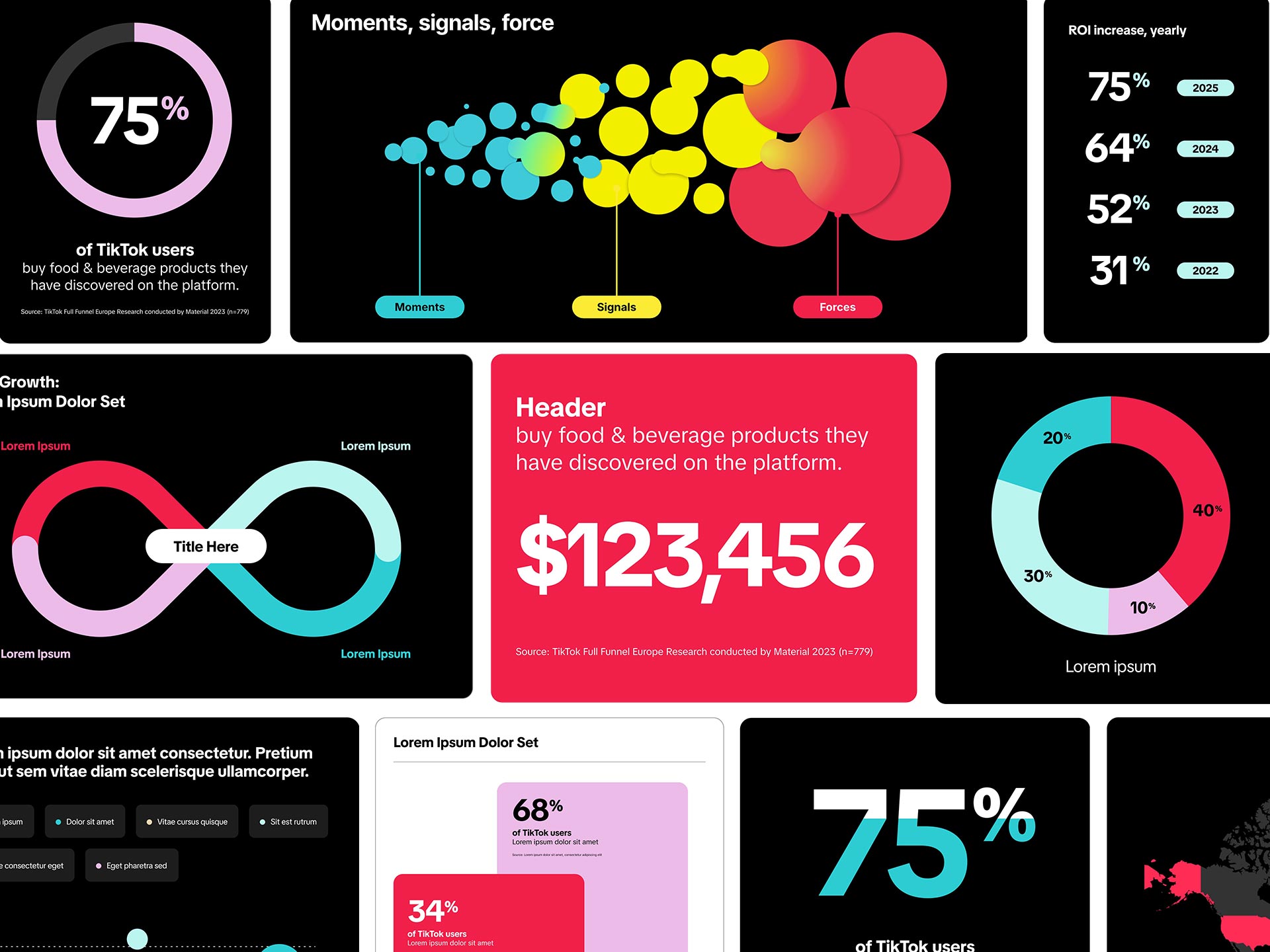
Data visualization became a cornerstone of sales enablement by transforming abstract metrics into compelling narratives that clients could instantly grasp. Instead of presenting numbers in static charts, the system framed insights with bold typography, dynamic layouts, and motion principles drawn from TikTok’s design language. This approach turned performance data into a storytelling tool, giving sales teams the ability to connect value propositions to real outcomes with clarity and impact. By elevating data beyond simple reporting, the toolkit empowered conversations that felt more persuasive, memorable, and culturally aligned with the platform’s creative energy.
.jpg)
Data visualization became a language of clarity and emotion. In the brand refresh, modular design principles were essential to building a system that could flex across every surface while remaining cohesive. The use of color, transparency, and rhythm allowed information to breathe and tell its own story, turning raw numbers into something that felt alive and intuitive. These visual cues carried meaning beyond their metrics, showing how audiences interact, how trends rise, and how creativity flows across categories. By designing a toolkit rooted in modularity, each element could evolve independently while contributing to a unified whole, making the brand not only scalable but expressive in every context.
To visually express TikTok’s multiplicity and cultural resonance, we introduced the signature glitch effect, symbolizing the convergence of countless subcultures, ideas, and creative voices that define the platform. This design language is more than aesthetics; it represents a living ecosystem where a musician’s viral sound can change their life overnight, a comedian’s short-form skit can ignite a movement, and a small business can scale globally from a single post. By marrying technical precision with expressive motion, TikTok’s identity communicates a world where creativity is infinite and deeply personal, capturing the emotional impact the platform has had on millions of creators. Rooted in the cyan and magenta tones you get in a 3D anamorphic effect, we found a place to root our color system and add motion to the brand system.
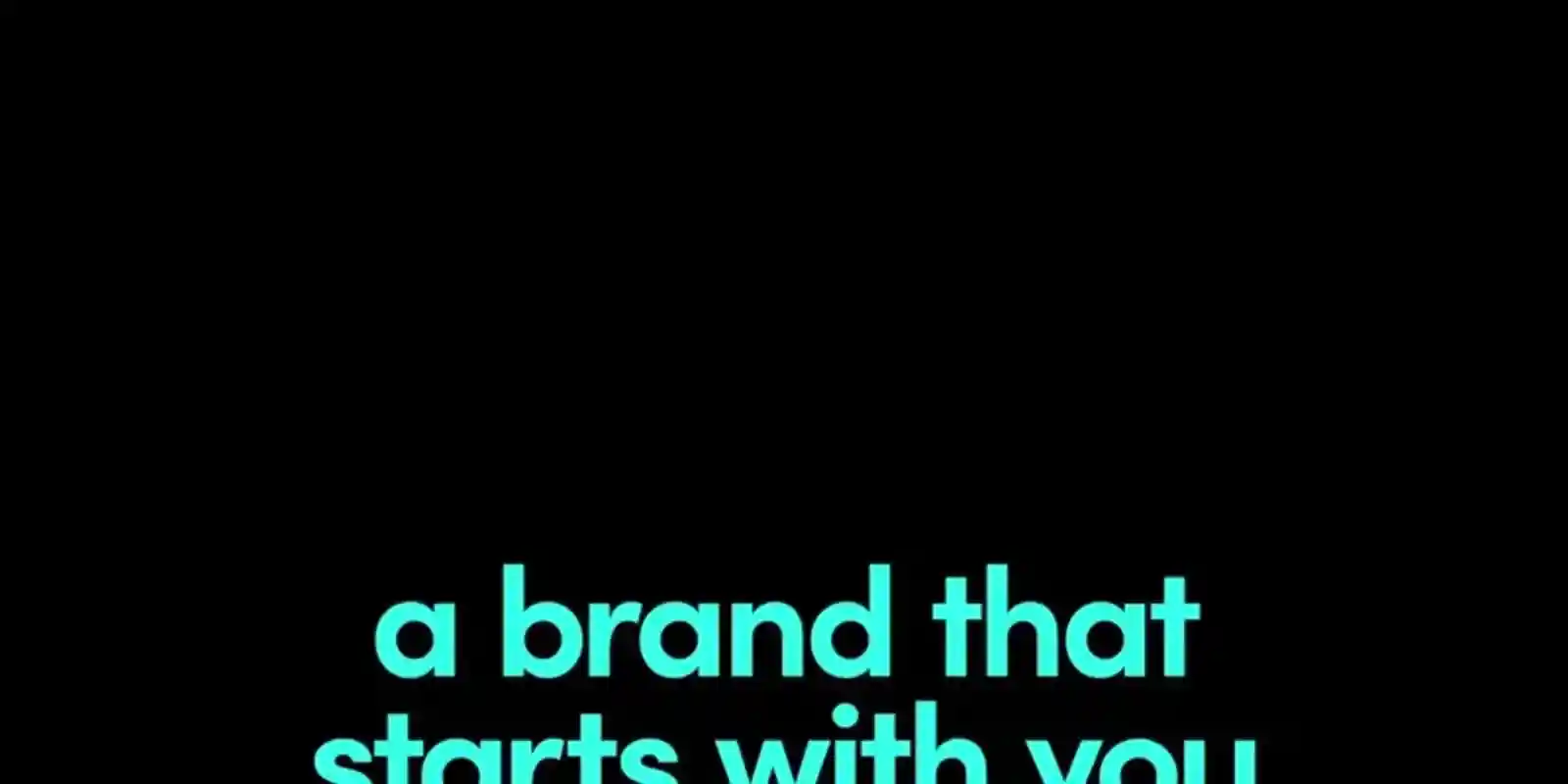
We worked to align every market under one coherent and consistent brand identity that could be instantly recognized anywhere in the world. This unity was central to our growth strategy, allowing us to present TikTok as a single, global voice while supporting local adaptations. My contribution was to reinforce the vision of one TikTok brand and ensure its values translated across all design decisions. As part of the brand guidelines refresh, and in an effort to develop this instant recognizability, we also developed and executed a comprehensive global brand photoshoot designed to equip our teams with a consistent library of imagery for sales decks, motion graphics, and sizzle content. Working in close partnership with Shutterstock Studios, we oversaw a photography studio production in North America while also coordinating global shoots with select creators in Brazil, Japan, and other priority markets.
1.jpg)
The goal was to ensure the imagery reflected the diversity of TikTok’s community across geographies, age groups, and cultural contexts. To guide the production, we built a robust set of photo guidelines that emphasized authenticity, inclusivity, and clarity of storytelling. These guidelines ensured that every image aligned with the refreshed brand identity, providing direction on composition, lighting, use of color, and tone of voice in photography. They also highlighted the importance of balancing polished brand presentation with a sense of spontaneity and approachability that is true to TikTok’s spirit. The shoots were carefully designed to represent a wide spectrum of people and key verticals where TikTok has strong influence, including gaming, cooking, sports, auto, and telco. Casting prioritized real individuals and creators who could bring credibility and relatability to the brand, helping to showcase how TikTok connects communities and fuels culture. The final image library now serves as a global resource, empowering teams to create materials that are visually unified, strategically aligned, and locally resonant. This work not only expanded the visual toolkit but also strengthened the foundation for how TikTok presents itself to partners, advertisers, and the broader creative community.

One of my favorite expansion elements that brought this personality and vibrancy to life in addition to our photography set was our sticker pack. I partnered with Crystal Yin and Joy Seet on my design team to guide our team in developing a comprehensive sticker pack that could be used across global markets. The goal was to create a versatile set of visual assets that carried TikTok’s energy and personality while remaining adaptable across formats and being eyecatching elements to fill negative space.
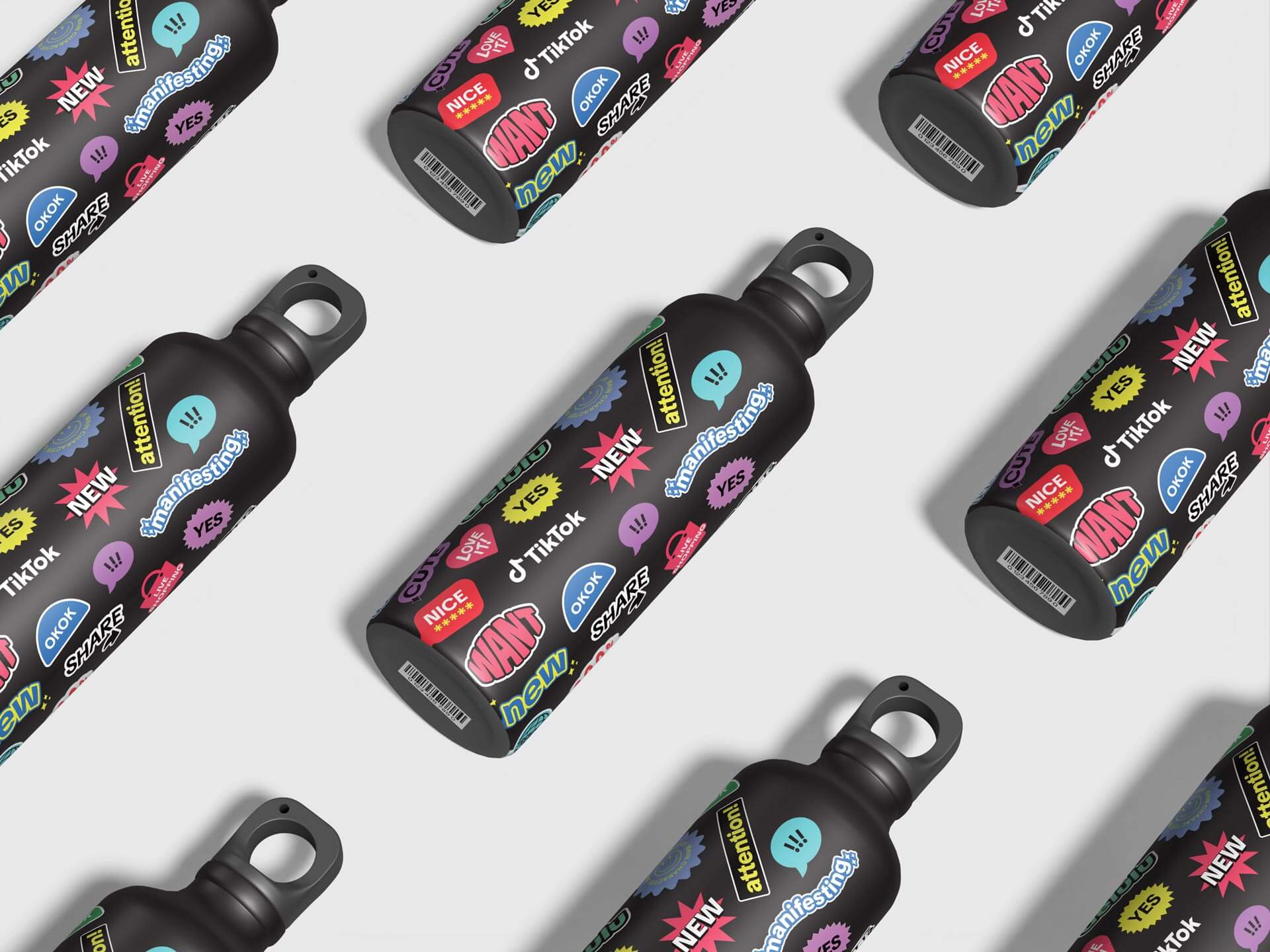
Working closely with our summer interns, Cassidy Cho and Kristine Xiu, we identified trending styles and themes from the platform that could translate into both text and photo-based stickers. I oversaw the process end to end, ensuring consistency with brand guidelines and maintaining a balance between playful creativity and professional usability. The final package was designed for broad application, from events to decks to social and digital channels, adding a layer of personality and vibrancy wherever they appeared. By curating a set that worked equally well in motion, presentations, and social content, the stickers became a flexible toolkit for teams worldwide. Their impact went beyond decoration; they functioned as a recognizable brand extension, emphasizing key messages and moments while giving layouts a fresh and engaging edge.
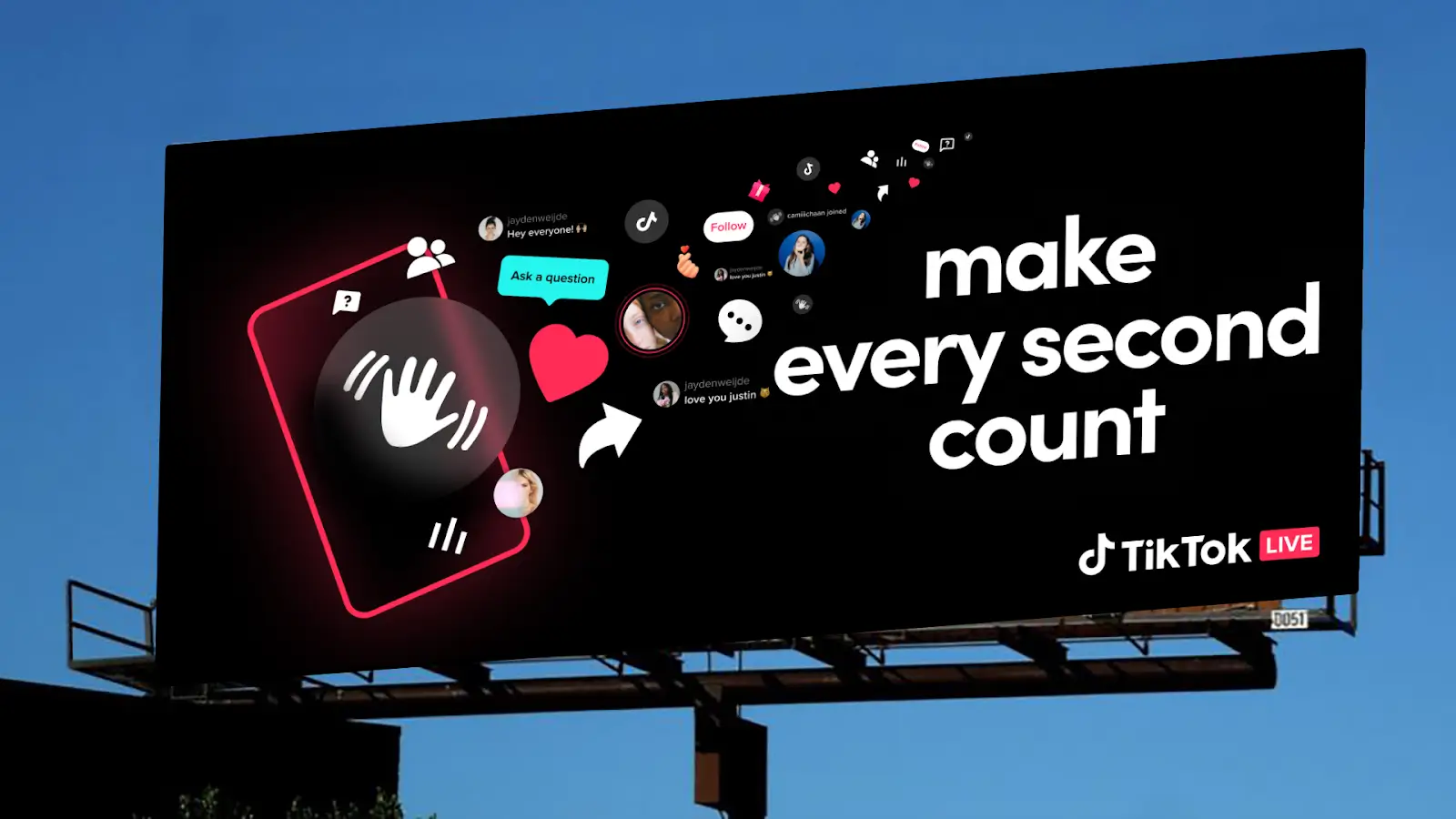
That was one of the big things about this design system, it really had to stretch across multiple global teams and functions from our user side, TikTok Live, TikTok Shop, TikTok for Business and more. The strategy centered on three components: creativity, humanity, and connection. We paired these with four personality traits that designers could actively work into their output: real, lively, daring, and encouraging. I guided the team in turning these high-level ideas into tangible design principles that could be applied consistently worldwide. On TikTok, we wanted to make sure the audience felt like we were expanding their spirit of creativity outward in our design visuals and creative expressions.
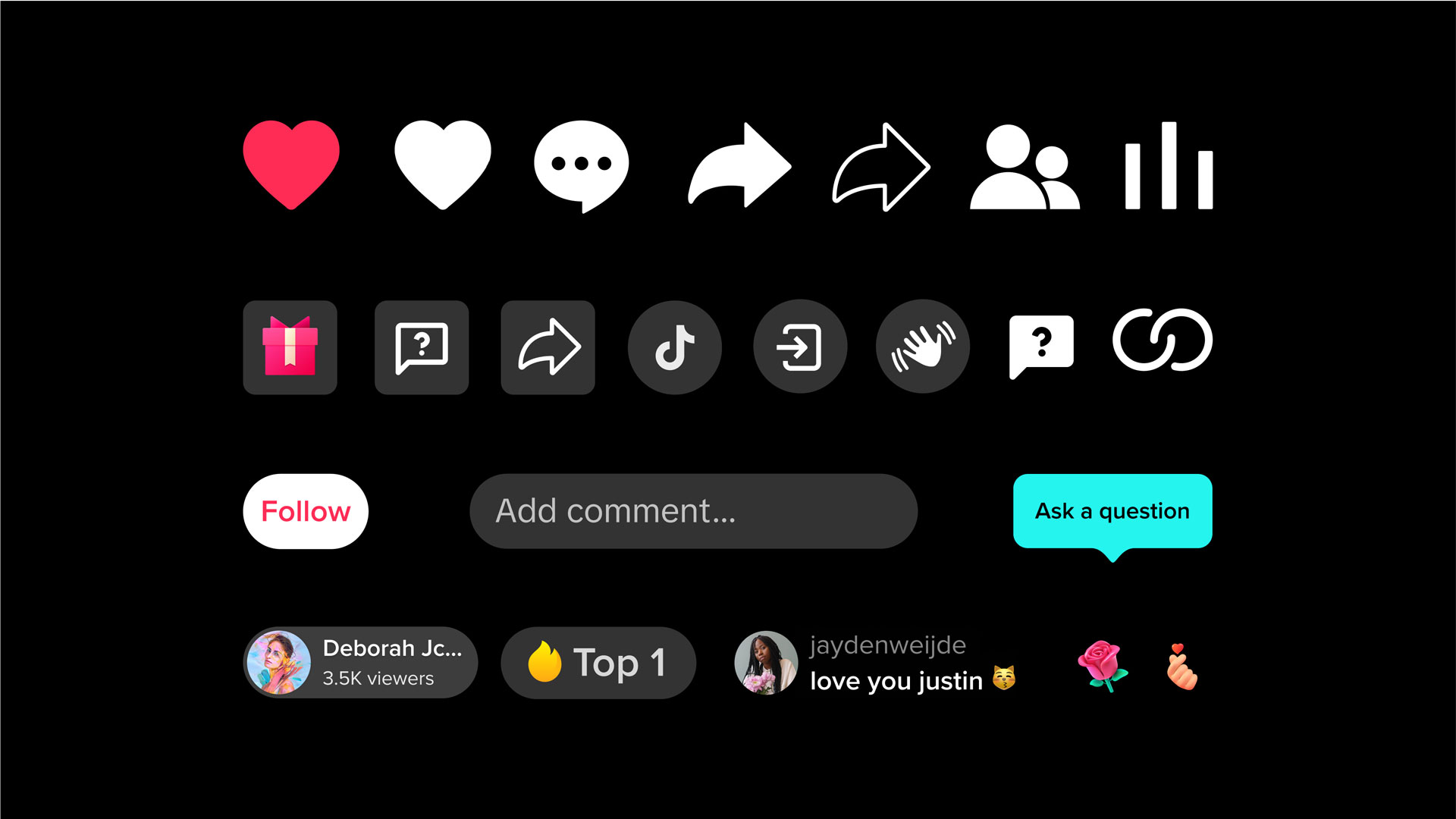
On the platform side, these principles were expressed through UI elements that balanced functionality with personality. From the way buttons pulsed with motion to the typography system designed for legibility across devices, every detail reinforced the brand’s energy while staying accessible to a global audience. Layout grids created cohesion between TikTok Live, Shop, and Business while leaving room for localized nuance. The system made the UI feel not only seamless and intuitive but also distinctly TikTok, ensuring the product experience embodied the same creativity and connection that defined our campaigns.
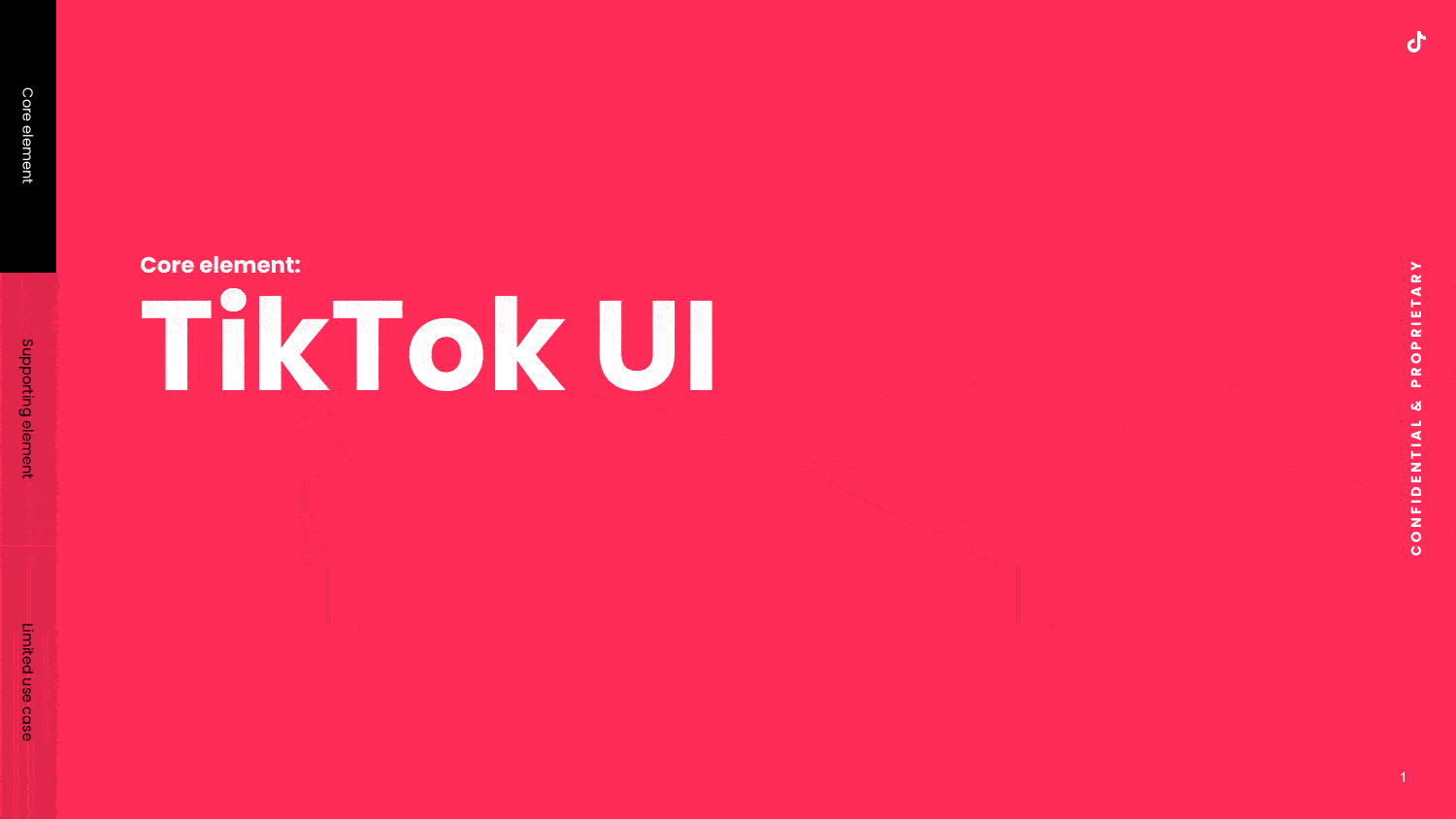
When showing the product, we stripped away nonessential UI elements so the focus stayed on the TikTok experience. The team simplified visuals by removing OS-specific details, captions, and clutter. I guided the approach to ensure product representation was clean, functional, and on-brand. Our photography and art direction embraced TikTok’s authentic, unpolished look. We focused on spontaneous moments, bright natural light, and a sense of attitude and diversity.
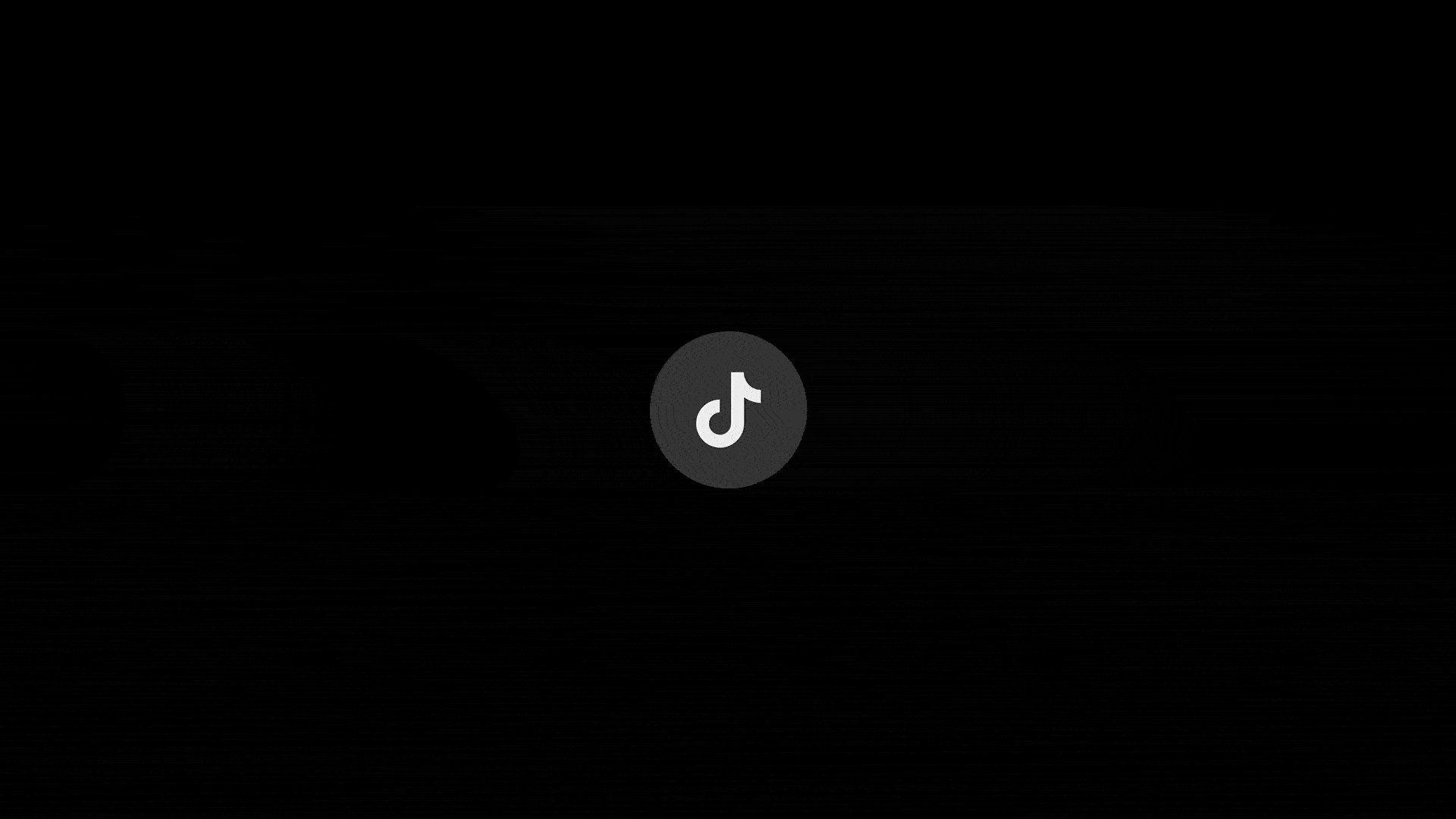
Discovery was established as a foundational principle of the design system, serving as both a creative and structural driver. The framework was intentionally designed to reflect TikTok’s core value of serendipitous exploration, embedding flexibility and modularity across motion, typography, and compositional grids. This ensured the system could scale globally while maintaining local relevance, enabling audiences to encounter content in ways that feel fresh and intuitive. By architecting discovery into the visual language itself, the design system reinforced TikTok’s positioning as a dynamic platform where culture is not only consumed but continually uncovered and redefined.
.jpg)
This work was showcased during a company-wide all-hands meeting where I presented new deck templates and data visualization updates to the entire organization, setting a higher standard for storytelling and design consistency. Blake Chandlee, President of Global Business Solutions and former Facebook exec, recognized this impact as transformative, noting that my creative vision captured the heartbeat of the platform and accelerated TikTok’s global growth. I had a chance to speak with him about it on set for one of our global gaming events, TikTok Made Me Play It, where he said that the energy of the company reminded him of his early days at Meta.
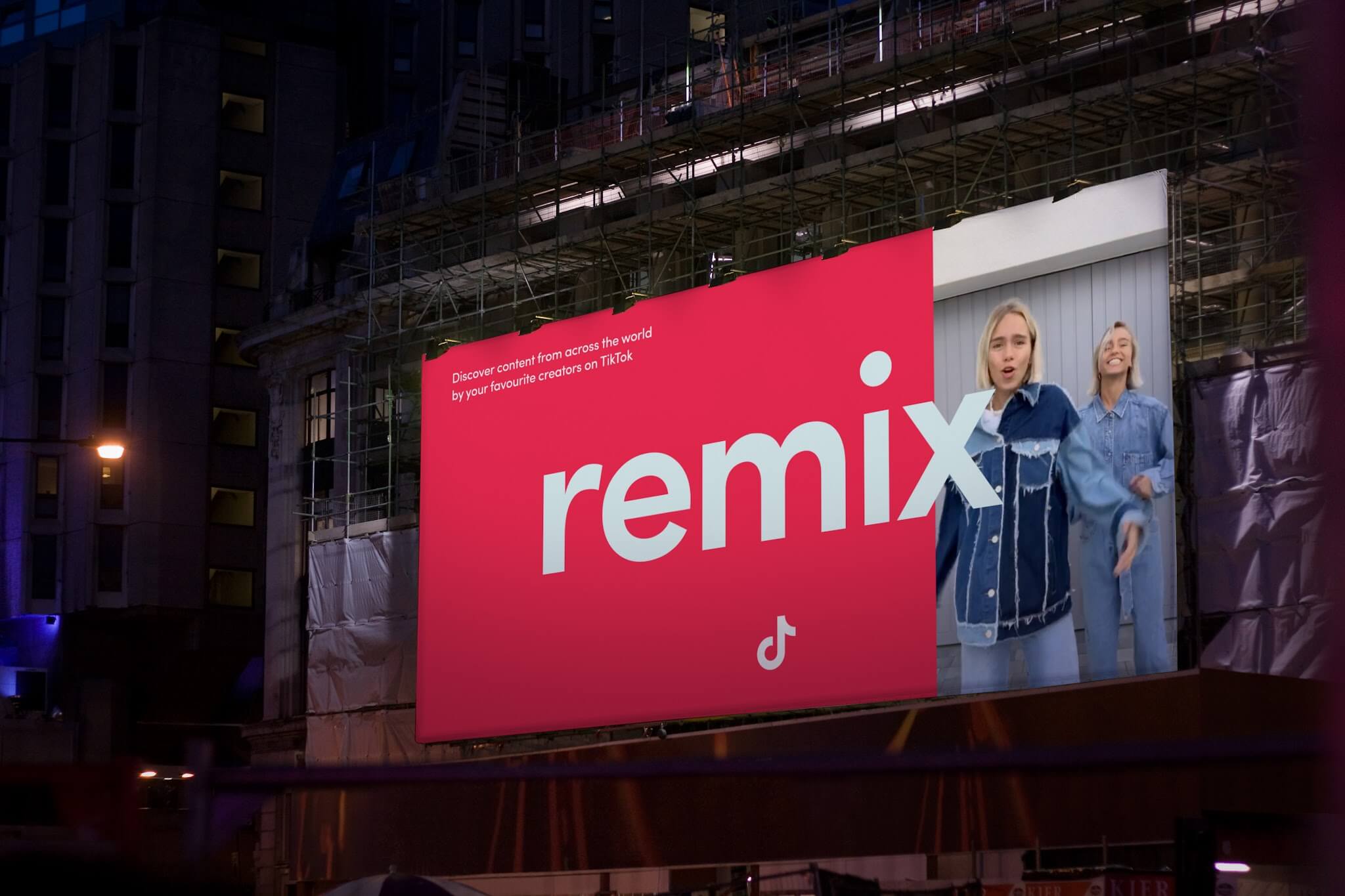
We defined a design system idea with Wolff Olins and our user side consumer team that captured TikTok’s spirit of remixing, surprising, and encouraging exploration. Whether it was a duet, the fun new content on your For You Page, or the origin of a new trend, we wanted the visuals to capture this energy. The identity needed to evolve constantly and stay fresh for every audience. My role was to work with the team to translate this concept into a system that could be scaled globally while retaining its sense of energy and discovery. By collaborating across the globe and with different functions, we were able to unify the brand across all the different parts of the organization.
%20(1).png)
Each personality trait was given a visual expression so it would show up consistently in our photography, typography, and layouts. “Real” felt confident and honest, “lively” felt energetic and boundless, “daring” felt expressive and current, and “encouraging” felt inclusive and motivating. I oversaw how the team embedded these traits into every creative asset, especially on the business side. There needed to be a feeling of boundless creativity and joy in all of our digital and physical touchpoints.
We built a flexible layout system that drew its structure directly from the layers of the TikTok logo, allowing our brand’s most iconic asset to become the foundation for design. The grid was intentionally crafted to feel dynamic rather than rigid, giving designers the ability to create endless unique compositions while still maintaining a cohesive visual language. Each layer could be combined, scaled, or remixed to suit the specific needs of a project, whether it was for core brand communications, campaign work, or creator-led experimental pieces. This grid is at the core of the TikTok Design System.
.gif)
The team invested significant effort in defining a set of modes that addressed different use cases, from full-bleed photography to graphic-heavy treatments, ensuring that every composition type had clear guidance for typography, color application, and logo placement. These modes became a toolkit that balanced versatility with brand control, making it easy for regional teams to adapt assets for their markets while staying true to the TikTok identity. My role was to oversee the overarching design direction, providing feedback at each stage with Hamilton Tamayo and Francis Mikhail to make sure the system captured TikTok’s sense of energy and playfulness without drifting into inconsistency. I worked closely with designers to refine the rules so they were clear enough to protect recognizability yet open enough to invite creative exploration, ensuring the layout system could thrive across both global campaigns and locally driven content.

My team and I were instrumental in developing the event franchise playbooks and templates that defined how TikTok shows up in real life across global markets. With a heavier concentration of activations on the business side, we made it a priority to bring creative and experiential oversight under our purview to ensure consistency, flexibility, and brand cohesion. We built a modular system of spatial design patterns, material guidelines, and installation options that could adapt to different scales and venues, from CES to Cannes Lions to SXSW. This meant thinking beyond aesthetics and into logistics, creating toolkits that covered everything from architectural layouts and lighting schemes to signage hierarchies, digital integration, and localized storytelling. Each playbook was crafted to balance creativity and efficiency, giving regional teams the freedom to adapt while preserving the same sense of TikTok energy and immersion no matter where in the world the experience unfolded.
.jpg)
The evolution of the design system unfolded more like an ecosystem taking shape than a project reaching completion. Each decision informed the next, creating a rhythm of observation, iteration, and response. It was less about defining absolute rules and more about shaping an environment where form and behavior could coexist in harmony. Typography, layout, and color were treated as interdependent forces that adapted through constant dialogue with real use. Nothing remained fixed for long because the goal was not permanence but resonance. The system learned from every launch, every market, and every creative experiment that stretched its edges, becoming stronger through participation rather than preservation, over time we were able to add in and build new elements to the toolkit to make it more robust.

Surprise and delight live in the small pivots that shift perception and invite a smile before thought can catch up. Within the TikTok brand system, these moments are woven into rhythm, pacing, and tone rather than layered on top. The idea is to create movement that feels alive and responsive, revealing something new each time without repeating the same trick twice. Visuals evolve through play, where color, scale, and tempo move together in unexpected harmony. This creates a sense of fluid unpredictability that mirrors the way content emerges and transforms on the platform. The work is not about control but about orchestrating chance, leaving room for discovery to appear naturally. In this way, delight becomes part of the design language itself, not as an interruption but as a pulse that reminds people that TikTok’s world is in constant motion, filled with surprise, and always ready to reveal another layer of wonder.
.jpg)
What emerged was a living framework that invited motion, variation, and discovery. Every component carried a sense of intention without feeling rigid, allowing the brand to breathe and evolve with culture. The process blurred the line between creation and calibration, treating feedback as fuel rather than correction. Teams across disciplines became co-authors in a shared language that valued rhythm over uniformity. Instead of striving for visual closure, the work stayed open, inviting new layers of meaning each time it was used. In that openness, the system found its continuity, growing through use rather than control, alive in every act of creation.

Certain verticals like gaming required their own specialized visual identities that spoke directly to the culture and language of those communities while still tying back to TikTok’s larger brand ecosystem. These teams needed deeper design exploration, from motion systems and typography treatments to color palettes and iconography that reflected the immersive, playful nature of the category. My role was to ensure that these tailored identities did not feel siloed but instead reinforced TikTok’s overarching creative DNA. By building connective tissue through consistent grid systems, type hierarchies, and motion principles, I created a framework where vertical-specific branding could thrive independently while still feeling unmistakably part of TikTok’s global story.
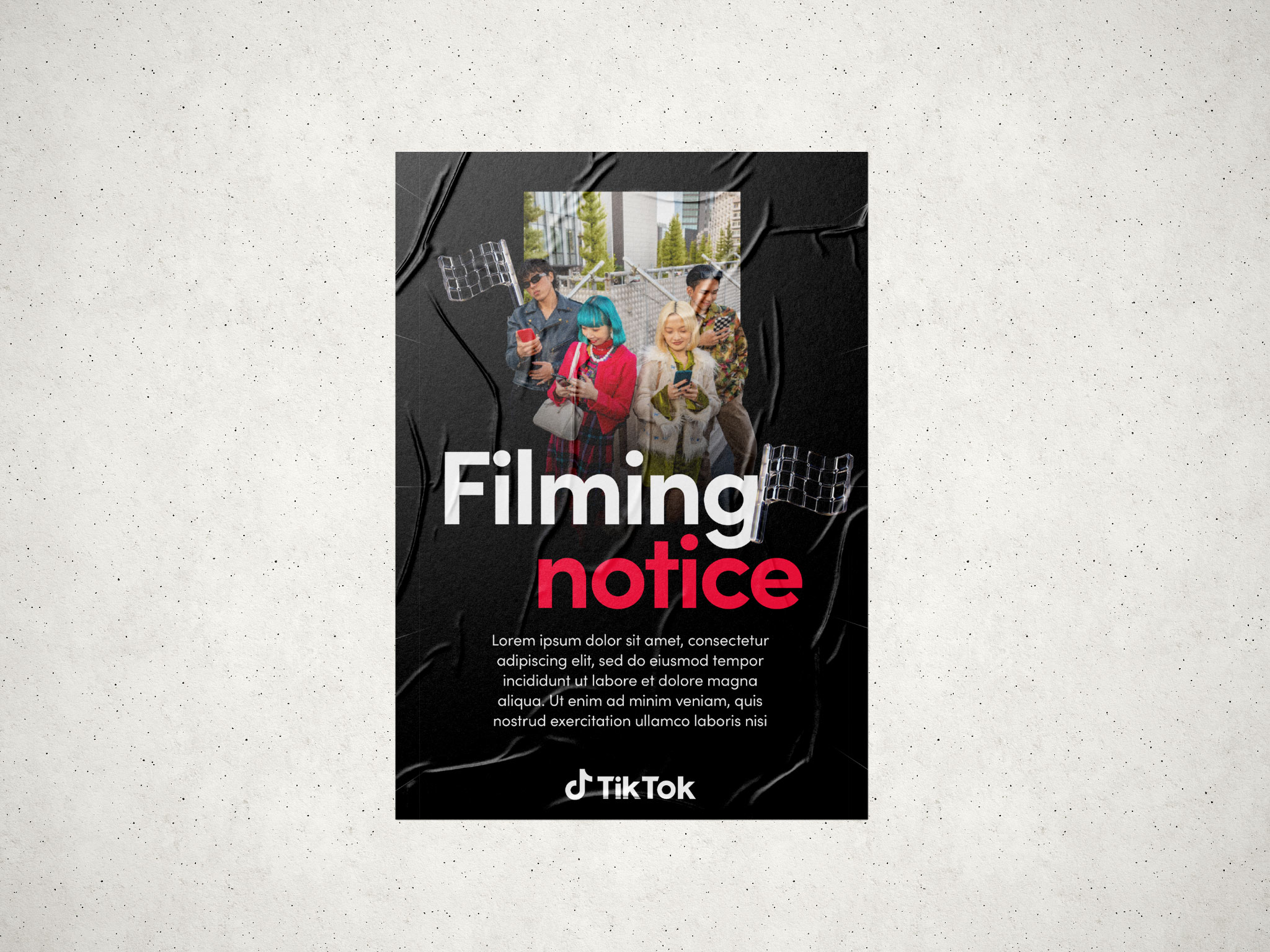
A major part of my role involved building out event franchise templates that could scale across verticals while still feeling distinctive and tailored to each audience. For flagship tentpole experiences like the For You Summit, TikTok’s owned and operated product announcement symposium, we needed a system that could flex between high-level brand storytelling and granular product education. I developed design frameworks that incorporated adaptable grids, modular layouts, and a consistent typographic hierarchy so that the visual language held strong whether applied to stage environments, keynotes, or social extensions. At the same time, for verticals like gaming, we introduced distinctive elements such as glass-like 3D icons that immediately signaled a more playful, immersive identity. These frameworks gave our experiential activations a repeatable structure without ever feeling formulaic, ensuring that each vertical had its own personality while remaining part of a unified TikTok ecosystem.
.webp)
We established clear rules for when to use core brand applications and when extended, more experimental approaches were appropriate. This helped teams understand when consistency was essential and when there was room to push boundaries. I helped define these boundaries so they supported both brand integrity and creative innovation. The team refined the logo system to ensure each version had a clear and distinct purpose. Guidelines for placement, scale, and color modes were created to protect the brand’s integrity.

The design system was intentionally engineered to operate across a spectrum of regional languages, market maturity levels, and brand awareness thresholds while maintaining the integrity of TikTok’s core identity. In high penetration markets, the system had to deliver advanced expressions that reinforced brand equity and cultural leadership, while in emerging markets it needed to introduce the platform with clarity, accessibility, and immediate recognition. Multilingual adaptability was embedded into the typographic and compositional frameworks, ensuring that scripts with differing densities, orientations, and character sets could coexist within a unified structure. This approach allowed the system to function as both an accelerator in established regions and an educator in newer ones, creating a consistent brand experience that was sensitive to local nuance. By balancing scalability with cultural specificity, the system ensured TikTok could speak fluently to global audiences without diluting its distinct identity as the platform of discovery and creativity.
Video content was designed to reflect the in-app experience while serving brand and marketing goals. The team defined rules for pacing, transitions, safe zones, and CTA styles. We created CTAs and stickers that aligned with the brand’s graphic language and were both functional and visually distinctive. The team set rules for size, placement, and legibility. I provided direction so these elements worked seamlessly with the surrounding content.
As the brand system matured, the video guidelines were conceived as a natural evolution of the static foundations, translating the core visual language into motion that felt true to the platform experience. The static framework of grids, typography, and color blocking established clarity and recognition, while the motion package extended these principles into dynamic behaviors that mirrored the upward swipe and perpetual flow of content. We defined how elements should enter, exit, and transition, creating a rhythm that was both intuitive and distinctive to TikTok. This ensured that motion was not treated as an afterthought but as an integrated component of the system, reinforcing the energy and immediacy of the brand. The guidelines provided teams with scalable rules for pacing, layering, and interaction, enabling consistency across markets and mediums while leaving room for creative interpretation.
.jpg)
A tight core palette was maintained for brand recognition, with the addition of pulling colors from UGC to harmonize with content. Rules such as the 30 percent brand color limit kept the look clean and distinct. I worked with the team to make sure these principles supported both flexibility and equity.
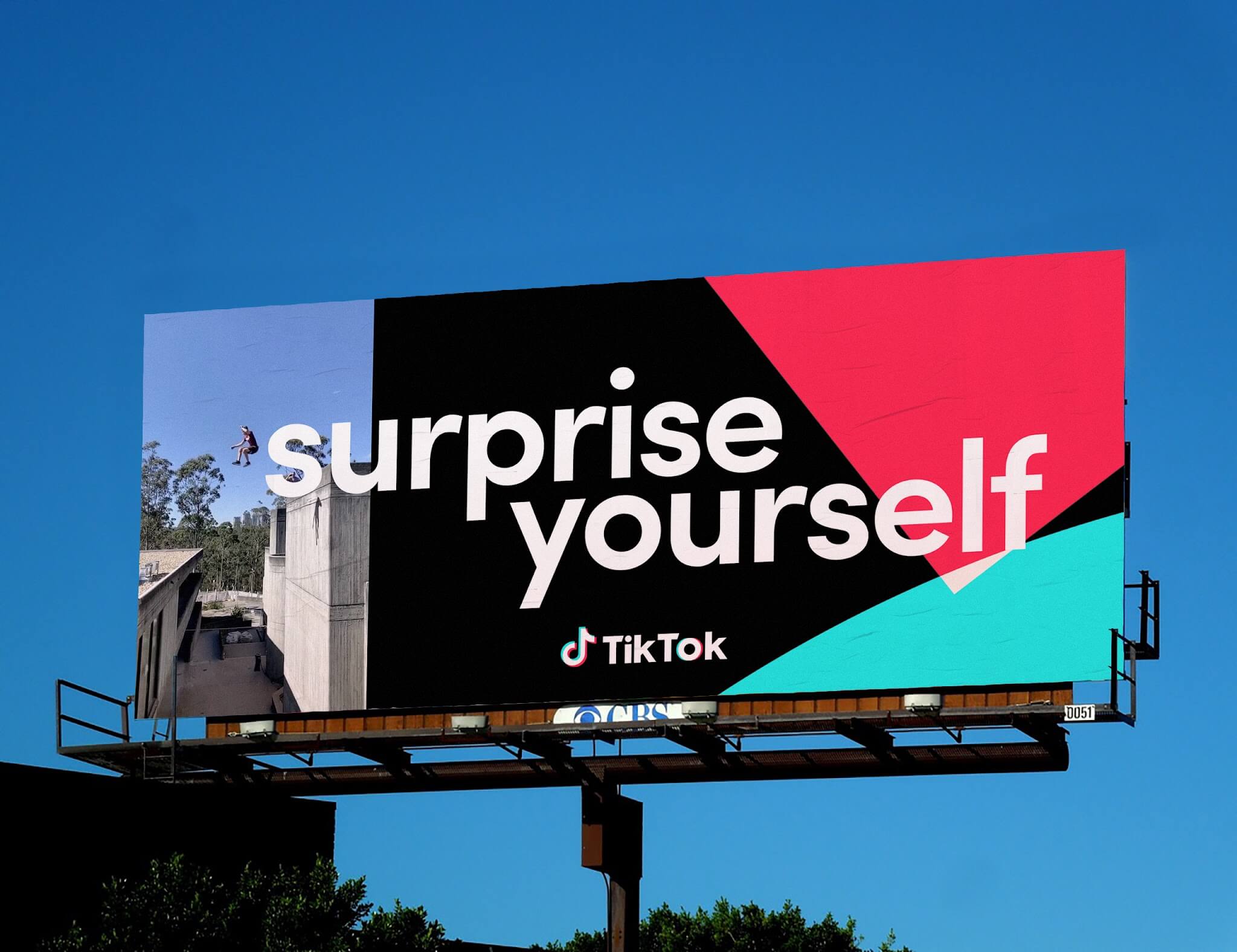
In-app banners were designed on a spectrum from TikTok-led to partner-led, with guidance on imagery, typography, and co-branding. This ensured banners felt native while meeting campaign needs. My involvement was in maintaining brand authenticity across both ends of the spectrum. Specific modes such as hero, story, overlay, and window had distinct rules for content and typography. A clear set of “don’ts” protected visual quality. I worked with creative leads to make sure these rules were easy to follow and reinforced consistency.
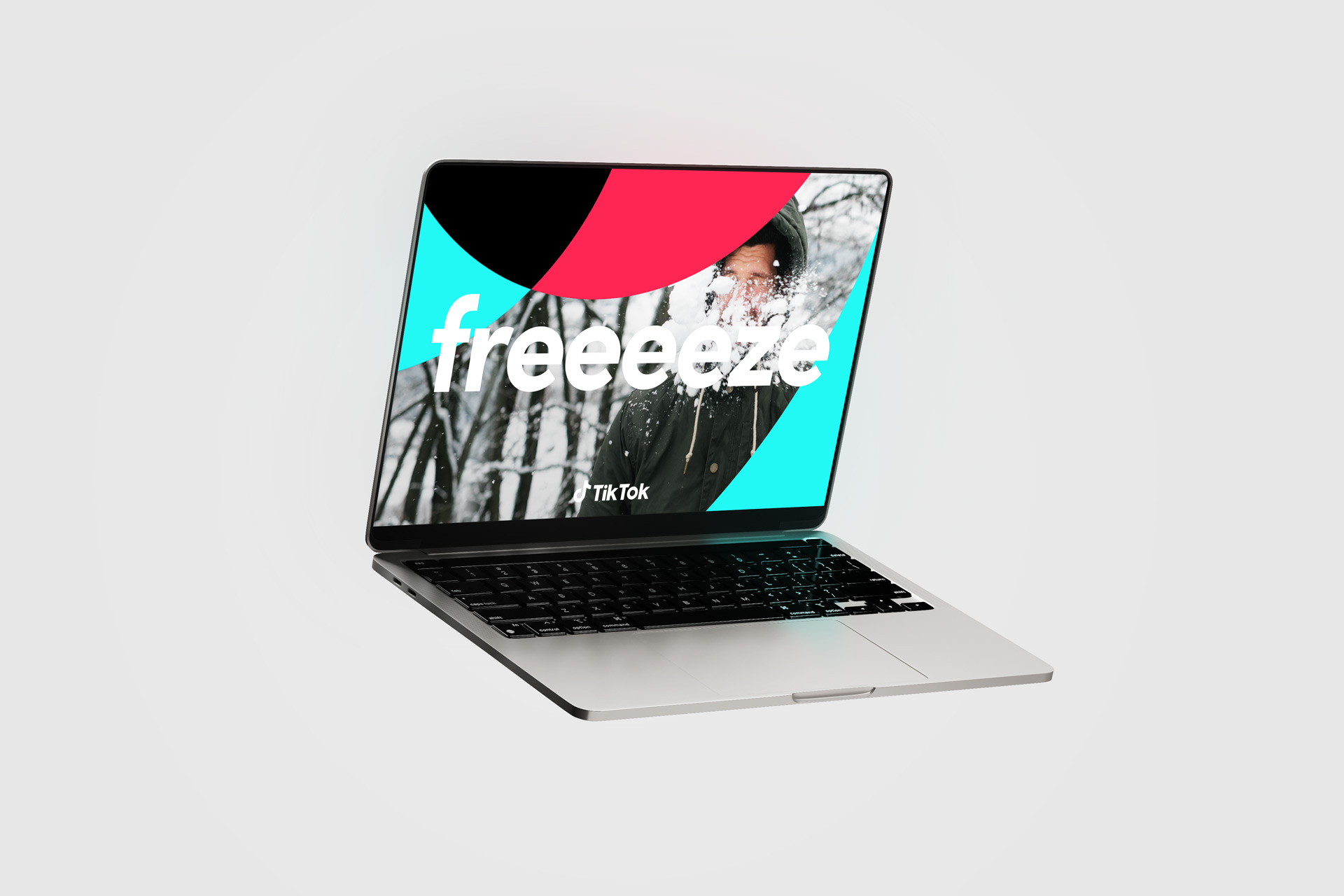
Profile and hashtag visuals followed precise sizing and safe-zone rules to ensure clean display at small scales. The team considered platform constraints in every specification. Internal presentations used core colors, bold typography, and fresh UGC to keep content vibrant and aligned with the brand. Templates balanced flexibility with a recognizable structure.
.png)
Our approach to swag was about creating items that people would actually want to use and wear, not just collect. The team designed apparel, accessories, and everyday objects that extended TikTok’s personality beyond the screen, using our typography, color palette, and patterns in ways that felt bold but wearable. We focused on pieces that sparked conversation and built affinity, whether they were given to employees, partners, or creators. My role was to make sure these items carried the same design integrity as our digital work, so every touchpoint reinforced the brand’s authenticity and energy.
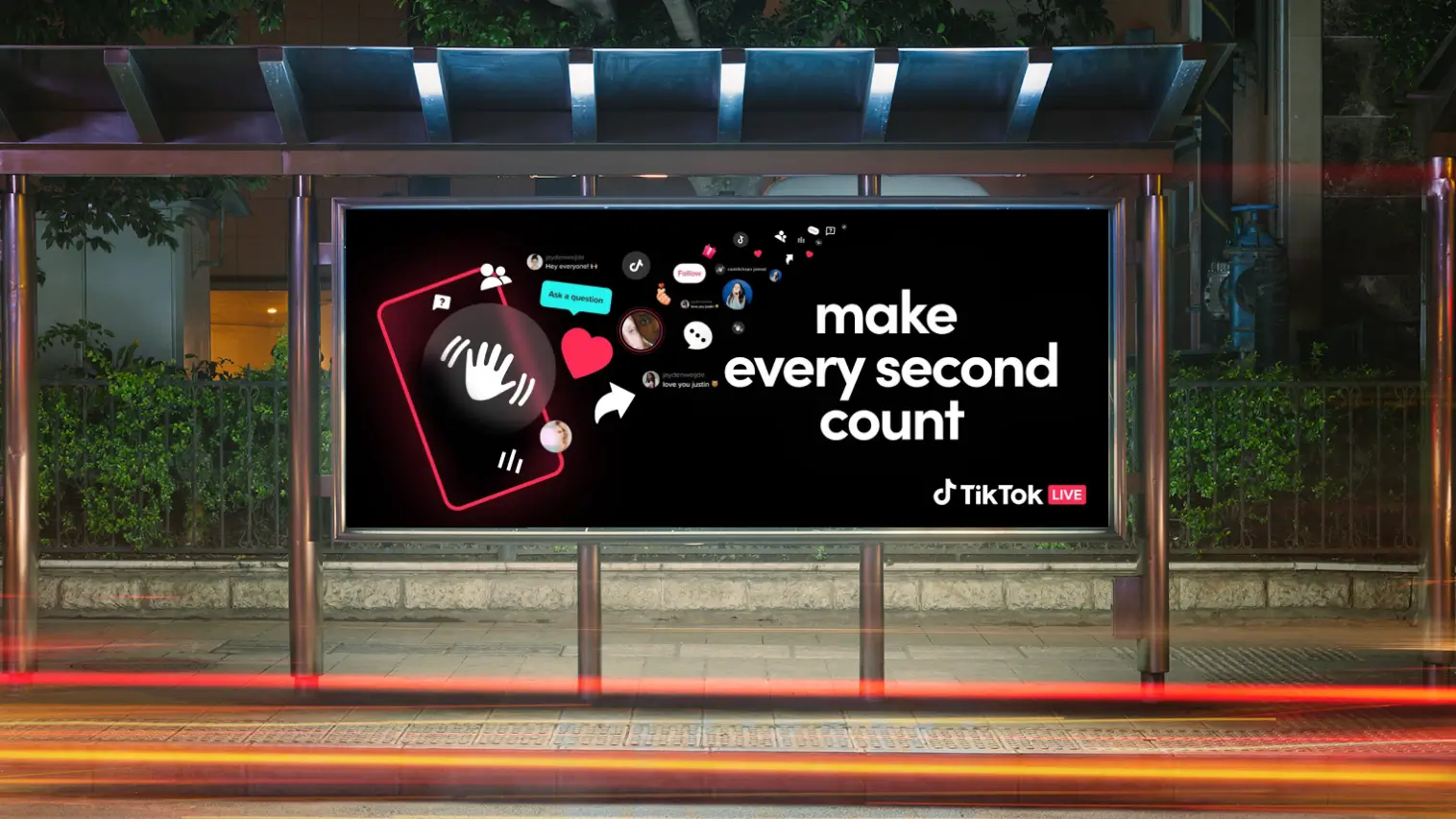
For out-of-home campaigns, the priority was to create immediate visual impact while staying true to our identity. The team adapted our design system for large-scale formats, considering viewing distance, motion elements, and environmental context. Billboards, transit wraps, and event signage became opportunities to bring TikTok’s dynamic and inclusive personality to physical spaces.
.png)
We approached brand perception as more than just visual recognition; it was about creating a presence that felt culturally relevant, globally connected, and unmistakably TikTok. Every campaign and activation reinforced our values of creativity, inclusivity, and connection, making sure the brand resonated both with creators and with the wider public. Through consistent application of our visual system and personality traits, we built an identity that felt vibrant and modern while earning trust and familiarity in diverse markets.
Our in-market presence was designed to meet audiences where they are and create memorable, shareable moments. This meant building campaigns that worked across multiple touchpoints, blending digital storytelling with impactful physical experiences. We paid close attention to how the brand translated across different cultures and cities, tailoring executions while keeping our core identity intact. Large-scale out-of-home activations became a key part of our strategy for embedding TikTok into the cultural landscape. Billboards in Times Square, Piccadilly Circus, Shibuya Crossing, and other high-visibility locations brought our bold visuals and energetic tone to millions of people every day. These placements acted as both a celebration of our community and a statement of our influence in the cultural conversation.
.webp)
The grid system was designed as the invisible backbone of our brand, giving structure to everything from digital campaigns to large-scale physical activations. Built from the layered geometry of the TikTok logo, it provided a flexible but consistent framework that allowed for endless compositions without losing recognizability. On digital platforms, the grid allowed assets to feel dynamic and adaptable, supporting multiple formats like social posts, in-app banners, and web layouts while preserving a clear visual hierarchy. In physical spaces, that same grid translated seamlessly to billboards, event signage, and environmental graphics, ensuring the brand felt just as intentional at 100 feet tall as it did on a mobile screen. By grounding all creative work in this shared system, the team could work faster and with more confidence, knowing that every output felt unmistakably part of the same visual family.
.jpg)
Our typography choices further anchored that consistency, with Sofia Pro serving as the primary typeface across all brand expressions. Its clean geometry and versatile weights allowed for expressive headline treatments while maintaining clarity and legibility in both short, impactful bursts and longer informational copy. On digital surfaces, Sofia Pro could be animated, staggered, or paired with motion to interact directly with content, reflecting TikTok’s energy. In physical formats, it held its integrity at scale, whether on a Times Square billboard or printed event collateral, maintaining strong legibility from a distance. The pairing of the grid system with Sofia Pro created a unified design language that bridged the gap between digital and physical, ensuring that no matter where someone encountered TikTok on their phone, on a poster, or in a massive OOH display, the experience felt cohesive, deliberate, and alive with the brand’s personality.
The TikTok brand guidelines are designed to move fluidly across mediums and subjects, adapting to the rhythm of culture rather than defining it rigidly. They live in motion, image, and sound, shaping how the brand expresses itself in ways that feel spontaneous yet intentional. Whether seen in a digital interface, an outdoor installation, or a live event, the system holds together through tone, balance, and clarity. It allows for experimentation while maintaining coherence, creating a visual and emotional language that feels alive in every context. The guidelines are less about constraint and more about harmony, guiding how creativity and identity coexist in the same breath.
.jpg)
Everything begins on TikTok. The stories we share in the world are seeded on the platform, shaped by the creativity of our community and the ways people use our tools to express themselves. Whether it is a jersey reveal for the Portland Thorns, a fan reaction at Providence Park, or a highlight clip that catches fire online, the content starts in the feed before it ever appears on a billboard, in a stadium, or on retail merchandise. By beginning on TikTok, we capture the authenticity and cultural energy that define the brand, and we make sure every activation in market feels true to the ecosystem our users create. This platform-first approach ensures that our personality and voice remain intact across every market and format.

TikTok’s power lies in the way it has extended beyond being a platform into becoming a cultural signifier. The brand shows up consistently across music, gaming, movies, sports, fashion, and everyday consumer behavior, positioning itself less as an app and more as a lifestyle brand. In music, TikTok has become the primary driver of chart success, with songs breaking on the platform before they hit streaming services or radio. In gaming, TikTok Made Me Play It and other vertical activations have shown how discovery and community transform gameplay into cultural moments. In film and television, TikTok drives conversation through fan edits, challenges, and viral campaigns that amplify launches. In sports, from NBA highlights to grassroots football, TikTok has become a second screen experience where culture and fandom unfold in real time.
.jpg)
I led the strategy and creative direction behind the full suite of TikTok’s enablement tools and guidelines that unified our brand presence across regions and empowered teams to operate with greater speed, confidence, and creative alignment. My focus was on building an ecosystem of resources that included presentation templates, data visualization hubs, GIF libraries, entertainment deck frameworks, sticker systems, and our signature PBS playbooks. Each of these was designed to help internal and regional teams self-serve with quality and consistency, dramatically reducing the need for external agencies and eliminating redundant workstreams. By standardizing design principles, tone of voice, and motion systems, these toolkits allowed us to move from fragmented regional output to a cohesive global visual identity. I collaborated closely with regional creative leads across EMEA, LATAM, and APAC to understand their challenges, then architected a shared design infrastructure that met both local and global needs. This cross-functional alignment turned what was once a scattered process into an integrated creative operation, cutting production time, maintaining brand integrity, and allowing TikTok’s visual storytelling to thrive across every platform, market, and business vertical.
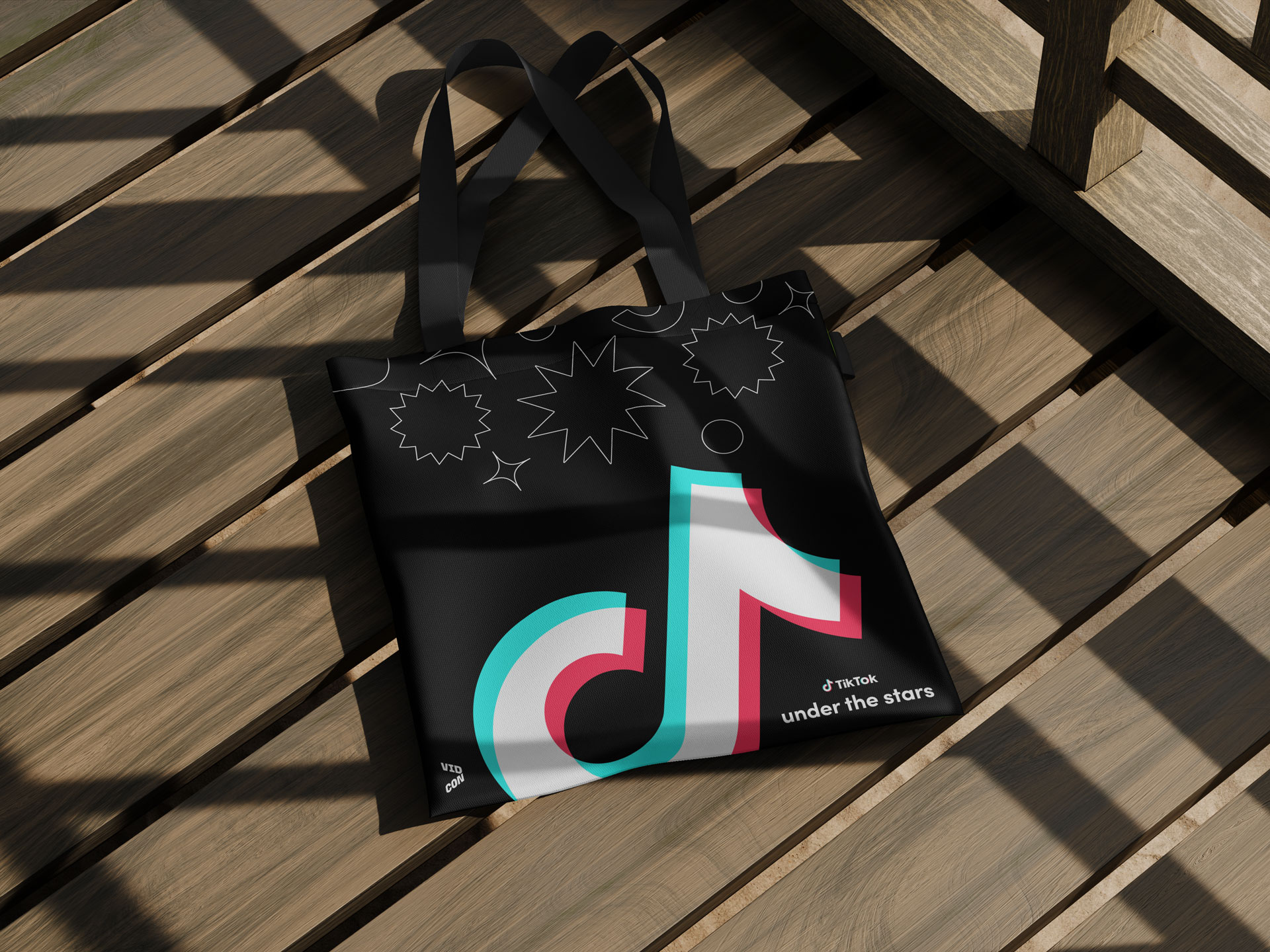
This cultural proliferation mirrors how iconic brands once anchored themselves in entertainment and lifestyle. Britney Spears made Pepsi feel like the soundtrack of a generation, Michael Jordan made Nike synonymous with aspiration and greatness, and TikTok is now weaving itself into the cultural fabric in a similar way. By embedding itself in the very spaces where culture is created and consumed, TikTok isn’t only a platform where trends happen but also a brand that symbolizes creativity, participation, and belonging. My work contributed to this larger vision by ensuring design direction, visual identity, and experiential activations tied each vertical expression back to the core TikTok brand, making sure the connective tissue was always there so the platform felt unified even as it scaled into every corner of pop culture.
.jpg)
Bringing these ideas to life requires deep collaboration across many teams. Wolff Olins provided the foundational brand strategy and visual framework, which our Creative Lab team built upon to design systems and executions that work for both the user side and the business side. Our global teams brought regional insight, ensuring the work resonated locally while maintaining a unified identity. The business side team helped translate creative concepts into campaigns that drive measurable results, while the user side kept us anchored in the authentic expressions of our community.
This collaboration was highly iterative, with open feedback between all groups, rapid prototyping, and shared problem solving. It allowed us to take ideas born on the platform and transform them into campaigns and activations that thrive equally well in a TikTok feed, on a stadium sleeve, or across iconic out of home locations worldwide.
Key Collaborators: Wolff Olins, Francis Mekhail, Stacey Dsylva, Julia Zhou, Joshua Covarubbias, Johnny Chiu, Natalie Matutschovsky, Snog Productions, Jinglu Li, Ryan Northway, Ye Lin, Fernando Wang, Yujie Li, Peijun Guo, Qinyi Yao, Eason Shen, Jessie Ning, Jerio, Alex Ng, Mercy Tee, Haoqi Wen, Shayna Wenger, Raisa Janjua, Ian Alexander, Hamilton Tamayo, Crystal Yin, Chang Ma, Jialu Li, Thomas Cheng, Lachlan Bradford, Guandong Li, Yunfeng He, Tiantuo You, Haoyu Wang, Jun Shen, Haohao Duan, Melon Lee, Yuhang Liu, Miaomiao Liu, Xiangyu Kong, Yixia Xu, Kristin Peak, Nilesh Patel, Belle Baldoza, Jenny Westin, Parris Pierce, Alex Polo, Mike Hinson, Joy Seet, Antonio Fragoso, Kenneth Liew, Rachel Horlick, Kitty Mok, Jason Gomez, Vanessa Rizk, Dana Spomer, Kristine Xiu, Cassidy Cho
Tools: After Effects, Photoshop, Illustrator, Figma, Cinema 4D, and Sketch
Deliverables: Brand Guidelines, Design System, Motion Package, Merch Guidelines, Product/UI Guidelines, Brand Photography, Presentation Templates